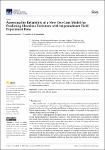Assessing the Reliability of a New One-Line Model for Predicting Shoreline Evolution with Impoundment Field Experiment Data
| dc.contributor.author | Francone, Antonio | |
| dc.contributor.author | Simmonds, David | |
| dc.date.accessioned | 2023-12-20T10:59:52Z | |
| dc.date.available | 2023-12-20T10:59:52Z | |
| dc.date.issued | 2023-05-12 | |
| dc.identifier.issn | 2077-1312 | |
| dc.identifier.issn | 2077-1312 | |
| dc.identifier.other | ARTN 1037 | |
| dc.identifier.uri | https://pearl.plymouth.ac.uk/handle/10026.1/21821 | |
| dc.description.abstract |
The advancement of knowledge in the field of coastal morphodynamics is currently highly relevant, as it provides valuable insights into the complex and dynamic nature of coastal systems and helps coastal engineers and researchers to better understand and manage the risks associated with coastal hazards. Managing and protecting coastal areas requires accurate measurements and the availability of reliable numerical models for predicting shoreline evolution. The present study focuses on verifying the reliability of a recent one-line model: the General Shoreline beach (GSb) model. The numerical simulations were performed using wave data observed by the Acoustic Wave and Current profiler and the Channel Coast Observatory buoy. The numerical results were compared with high-resolution shoreline data collected from an ARGUS monitoring station during the impoundment experiment conducted in Milford-on-Sea, UK. The numerical results demonstrated that the GSb model accurately predicts shoreline evolution, particularly for mixed beaches. The findings of the present study also show the effectiveness of the GSb online numerical model in predicting day-to-day changes in shoreline dynamics caused by wave attack. The high-resolution dataset of the ARGUS observations combined with wave data collected during the field experiment could be valuable resources for coastal researchers to further evaluate and improve numerical models of coastal morphodynamics. | |
| dc.format.extent | 1037-1037 | |
| dc.language | en | |
| dc.publisher | MDPI AG | |
| dc.subject | coastal zone | |
| dc.subject | shoreline evolution | |
| dc.subject | coastal morphodynamics | |
| dc.subject | GSb model | |
| dc.subject | numerical simulations | |
| dc.subject | field data | |
| dc.subject | ARGUS images | |
| dc.title | Assessing the Reliability of a New One-Line Model for Predicting Shoreline Evolution with Impoundment Field Experiment Data | |
| dc.type | Journal Article | |
| plymouth.author-url | https://www.webofscience.com/api/gateway?GWVersion=2&SrcApp=PARTNER_APP&SrcAuth=LinksAMR&KeyUT=WOS:000997206600001&DestLinkType=FullRecord&DestApp=ALL_WOS&UsrCustomerID=11bb513d99f797142bcfeffcc58ea008 | |
| plymouth.issue | 5 | |
| plymouth.volume | 11 | |
| plymouth.publication-status | Published online | |
| plymouth.journal | Journal of Marine Science and Engineering | |
| dc.identifier.doi | 10.3390/jmse11051037 | |
| plymouth.organisational-group | |Plymouth | |
| plymouth.organisational-group | |Plymouth|Research Groups | |
| plymouth.organisational-group | |Plymouth|PRIMaRE Publications | |
| plymouth.organisational-group | |Plymouth|Faculty of Science and Engineering | |
| plymouth.organisational-group | |Plymouth|Faculty of Science and Engineering|School of Engineering, Computing and Mathematics | |
| plymouth.organisational-group | |Plymouth|Research Groups|Marine Institute | |
| plymouth.organisational-group | |Plymouth|REF 2021 Researchers by UoA | |
| plymouth.organisational-group | |Plymouth|Users by role | |
| plymouth.organisational-group | |Plymouth|Users by role|Academics | |
| plymouth.organisational-group | |Plymouth|REF 2021 Researchers by UoA|UoA12 Engineering | |
| plymouth.organisational-group | |Plymouth|Research Groups|COAST Engineering Research Group | |
| plymouth.organisational-group | |Plymouth|REF 2028 Researchers by UoA | |
| plymouth.organisational-group | |Plymouth|REF 2028 Researchers by UoA|UoA12 Engineering | |
| dc.date.updated | 2023-12-20T10:59:45Z | |
| dc.rights.embargodate | 2023-12-21 | |
| dc.identifier.eissn | 2077-1312 | |
| rioxxterms.versionofrecord | 10.3390/jmse11051037 |


